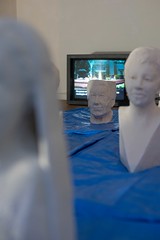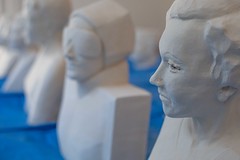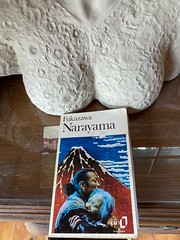楢山
installation 2020
grateful to Mit Hendrickx, my Mother
21 sculptures in ceramics, unique pieces, clay fired on 1050°
Marie Julia Bollansee, modelling 21 portraits of my mother
21 blue tarpaulins
video, 11’18” on 27”PVM
Marie Julia Bollansee, concept, camera, editing
FUKAZAWA Shichiro, The Ballad of Narayama, text
KOGA Rieko en FUJII Sayuri, voices
Cynthia Vertessen, photographs of the installation
documentary video, 1’43”, chronology of the sculptures
an elaborate inventory of the installation, you can find it here
‘Narayama’ literally means “The Mountain with the Oaks”. Narayama is a
mythical mountain in the North of Japan where old people are brought to die.
FUKAZAWA Shichiro wrote ‘The Ballad of Narayama’ in 1956. We became acquainted
with the story in Europe thanks to the film adaptations that were made. It is
a fairy tale about this mythical mountain and about life in the village at its
foot. Two elderly people have reached the age of 70, O Rin and her neighbour
Mata-yan, so their time to go to Narayama has come….
Now that my mother and I regularly go out for walks together, I have noticed
there are also many oaks in our village. My mother is in a wheelchair and I
push her along. We take our walks under the oak trees, towards the graves of
her loved ones, to her friend in Huize Walden, to the Trappist Abbey, to the
all but vanished ruins of my grandmother’s house,… The film was recorded
during the walks I took with my mother, with the camera mounted on the
wheelchair. The texts were recorded by KOGA Rieko and FUJII Sayuri, both of
them artists who work in Tokyo and in Paris. They read the ‘lines of the
pilgrimage’ from FUKAZAWA’s ‘The Ballad of Narayama’ from the original
Japanese story. This film is part of the installation NARAYAMA, together with
21 portraits of my mother.
This summer I modelled portraits of my mother at all stages of her life, from
the age of 7 to 90 years old. I installed a studio in the garden shed of her
flower and vegetable garden, so I could be close to her. My mother keeps old
photographs in a tin. Every photograph tells a story. She has written the
dates on the back of the photographs; her whole existence allows itself to be
read, her life surrounded by her family members, whom she has always take care
of. The white ceramics on a tarpaulin-blue background bear a clear resemblance
to the Renaissance Madonna’s by the Della Robbia brothers. The blue tarpaulins
hold the sculptures of a human life and I ascribe to them the imagined road to
Narayama.
_ Étude a propos des chansons de Narayama, Shichiro Fukazawa, pub. Gallimard
1959, translated from the Japanese into French by Bernard Frank, p. 20._



















